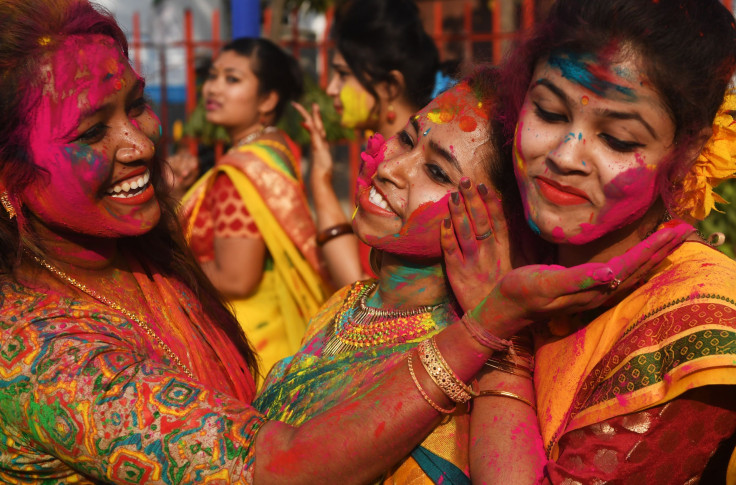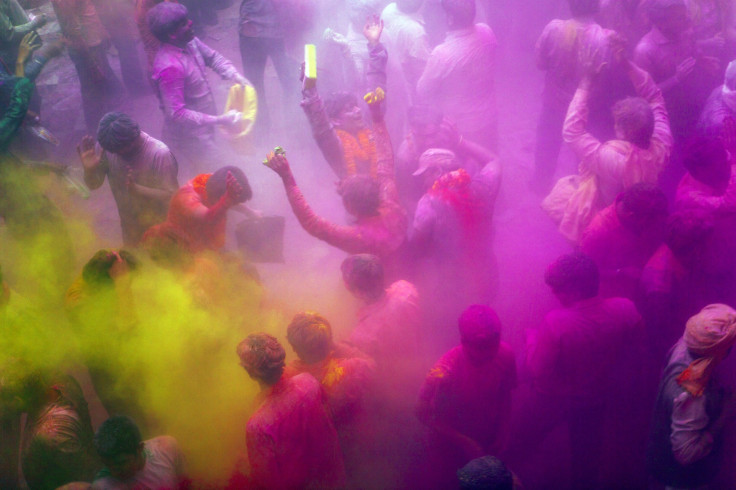Happy Holi 2018: Facts For India's Spring Festival Of Colors Celebration
The festival of colors or Holi will be celebrated March 1-2, i.e. Thursday and Friday, when people will color their loved ones with an array of hues, indulge in delicacies and sweets specially made for the occasion and, in short, have the time of their lives.
Streets in India are transformed into a big party during Holi, as color cakes people’s faces, colored water fills water tanks and buckets and a general spirit of fun pervades the air. Here are some interesting facts about the festival:
1. There are a number of legends surrounding the festival of Holi. Perhaps the most popular one is from Hindu mythology of the evil King Hiranyakashyap, who forbade his son Prahlada from worshipping the Hindu god Vishnu. After being caught worshipping Vishnu despite his father’s orders, Prahlada was punished by Hiranyakashyap and ordered to sit on top of a burning pyre, according to the Fact File.
Prahlada was joined by Holika, the king’s sister, who was immune to fire. However, Holika ended up being scorched to death by the hot flames, while Prahlada, who was praying to Vishnu during the event, walked away unscathed.

The name “Holi” is derived from the name “Holika,” and the various colors are supposed to represent flames of the fire. Parents often tell their kids this mythological story to teach them that good always prevails over evil.
2. Another legend tells the tale of the dark-skinned Hindu god Lord Krishna, who was jealous of his lover Radha’s fair skin when he was young. He believed she would never choose him because of his skin color. As per his mother’s advice, Krishna took some colored powders and smeared them on Radha’s face so that her original skin would be masked. This act went on to become a tradition and form the festival of Holi.
3. The saying “Bura na maano, Holi hai!” – which translates to “Don’t be offended, it’s Holi!” – can be heard uttered by many who participate in the festival of colors. The sentiment behind the saying is that people use this occasion to let bygones be bygones and extend the hand of friendship. However, mischievous children (as well as adults) use the phrase after pelting water balloons or spraying color-filled water on complete strangers during Holi, to get out of trouble.

4. Holi is celebrated over two consecutive days in the month of “Phalguna,” which generally falls between February and March. The exact date of the festival keeps on changing every year and is decided as per the Hindu calendar. The first day is known as “Holika Dahan” or “Chhoti Holi” and the second day is called “Rangwali Holi,” “Dhuleti,” “Dhulandi” or “Dhulivandan.”
5. One of the special delicacies prepared for the occasion is “gujiya,” a traditional sweet made with milk and sugar and stuffed with dry fruits and other sweet items. While children stuff themselves with “gujiya,” adults indulge in “thandai” or “bhang,” which is a milk-based drink made with ground cannabis.
6. The festival of Holi is no longer restricted to India. Organizations like Festival Of Colors USA plan Holi events in states such as California, Nevada, and Utah every year. These events feature live music, yoga, dance, and traditional Indian cuisine. New York City’s “Holi Hai,” on the other hand, promotes diversity, inclusion, and equality for all, by hosting live performers from Sufi singers to traditional Punjabi dancers.
© Copyright IBTimes 2024. All rights reserved.












